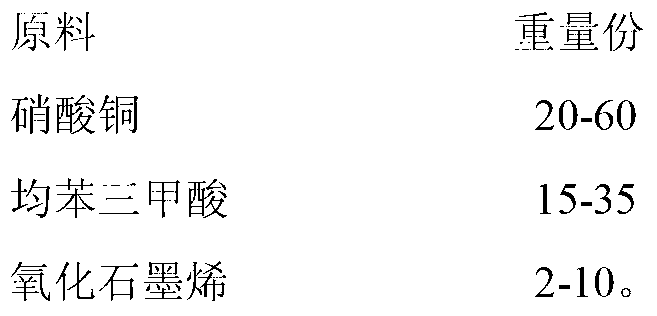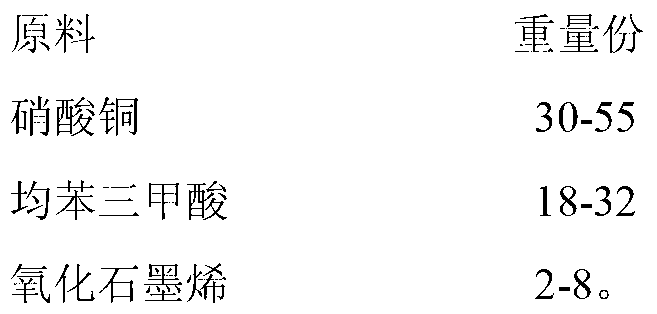Adsorbent for treating dye wastewater in different concentrations and preparation method and application
A dye wastewater and adsorbent technology, applied in chemical instruments and methods, textile industry wastewater treatment, adsorbed water/sewage treatment, etc., can solve the problems of unstable aqueous solution, high treatment cost, easy skeleton collapse, etc., and achieve short treatment time. , The effect of simple raw materials and low production cost
- Summary
- Abstract
- Description
- Claims
- Application Information
AI Technical Summary
Problems solved by technology
Method used
Image
Examples
Embodiment 1
[0033] An adsorbent for treating dye wastewater with different concentrations is made of the following raw materials in parts by weight:
[0034]
[0035] A preparation method for treating different concentrations of dye wastewater adsorbents, the steps are:
[0036] a) Weigh trimesic acid, copper nitrate, and graphene oxide raw materials in parts by weight, weigh 0.5302g trimesic acid, dissolve in 15mL absolute ethanol, and obtain solution A; weigh 1.0898g copper nitrate, dissolve in In 15mL of water, obtain a copper nitrate solution, then weigh 0.16g of graphene oxide, put it into the copper nitrate solution, and ultrasonically disperse the graphite oxide in the solution to obtain solution B; put solution A and solution B in a 50mL reaction kettle, The reaction temperature is 115 or 118 or 120 or 122 or 125°C;
[0037] b) Using temperature programming (that is, setting a certain heating rate), the heating rate is 4 or 5 or 6 °C / min, after the reaction time is 8 or 9 or 1...
Embodiment 2-6
[0042] Embodiment 2-6 (weight part)
[0043]
[0044] Its preparation method is identical with embodiment 1.
Embodiment 7
[0046] Methylene blue was used to simulate dye wastewater, and the concentration of methylene blue was 3.6mg / L. Add 0.1g of adsorbent to 100mL of dye wastewater (dosing concentration is 1.0g / L), shake for 20min, then let it stand still, take the upper clear layer to measure its absorbance, and calculate the concentration of residual methylene blue through the relationship between absorbance and concentration , The removal rate of methylene blue is calculated to be 98.17%.
PUM
 Login to View More
Login to View More Abstract
Description
Claims
Application Information
 Login to View More
Login to View More - R&D
- Intellectual Property
- Life Sciences
- Materials
- Tech Scout
- Unparalleled Data Quality
- Higher Quality Content
- 60% Fewer Hallucinations
Browse by: Latest US Patents, China's latest patents, Technical Efficacy Thesaurus, Application Domain, Technology Topic, Popular Technical Reports.
© 2025 PatSnap. All rights reserved.Legal|Privacy policy|Modern Slavery Act Transparency Statement|Sitemap|About US| Contact US: help@patsnap.com



